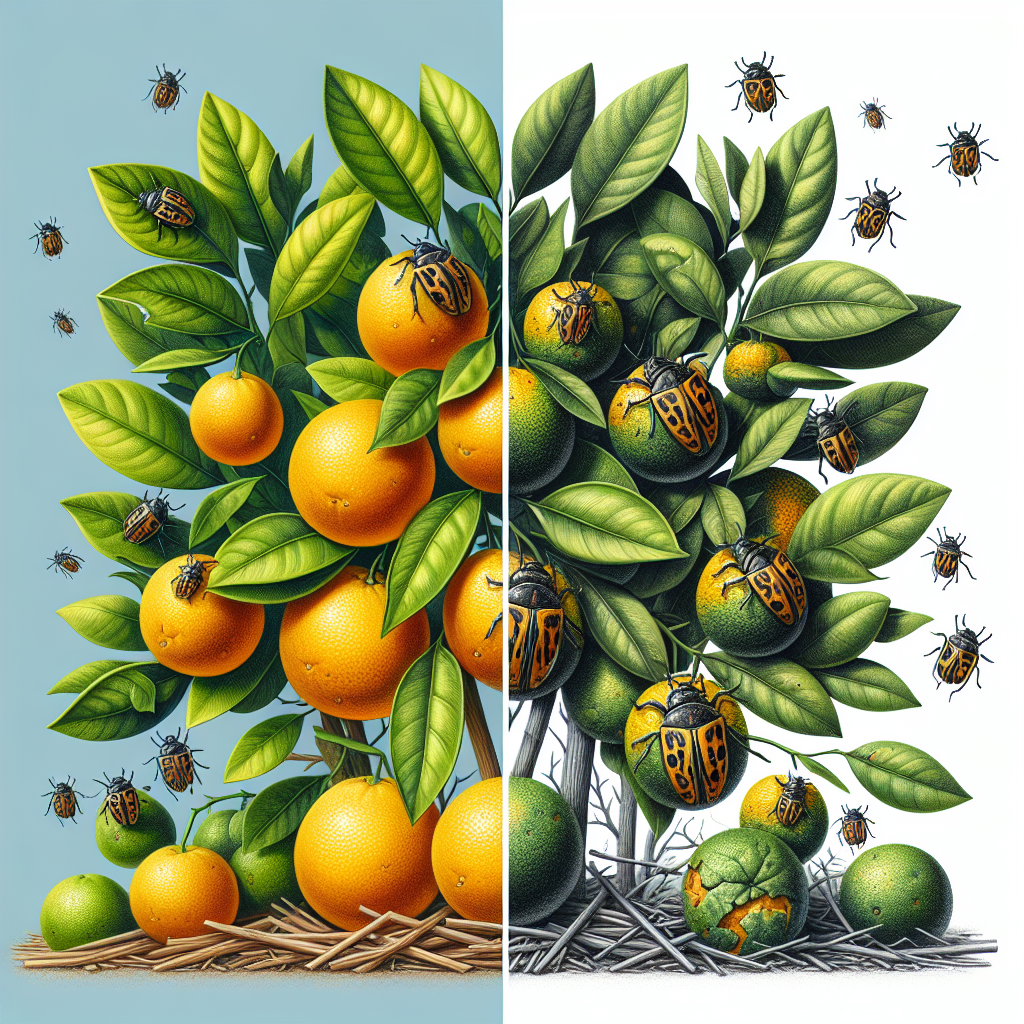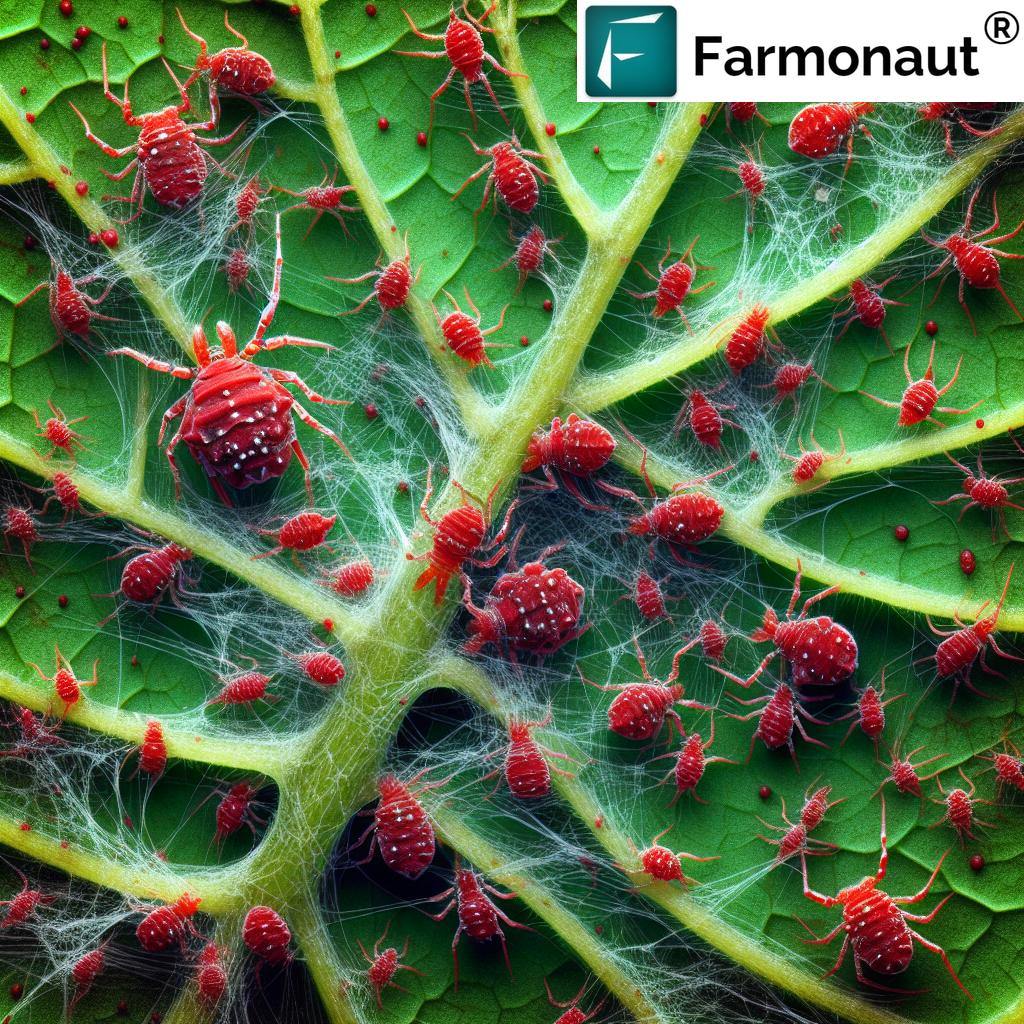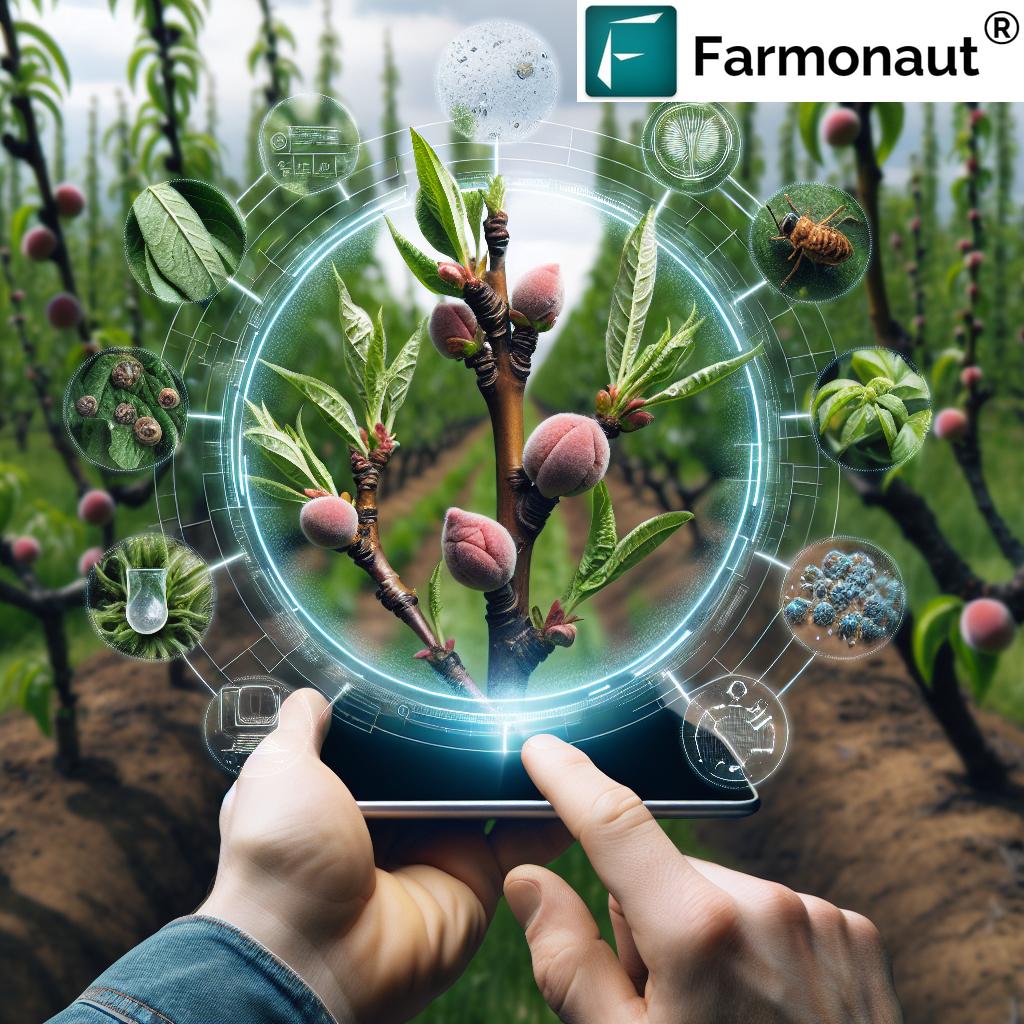Citrus Pests Unveiled: Identifying and Managing Loopers, Semiloopers, and Stink Bugs in Your Orchard

In the world of citrus cultivation, maintaining a healthy and productive orchard is a constant challenge. Among the myriad of issues that citrus growers face, citrus insects pose a significant threat to crop yield and quality. In this comprehensive guide, we at Farmonaut will delve deep into the world of citrus pests, focusing specifically on the citrus looper, citrus semilooper, and citrus stink bug. We’ll explore their identification, life cycles, damage patterns, and most importantly, effective management strategies to keep your citrus trees thriving.
1. Introduction to Citrus Pests
Citrus orchards are a haven for a diverse array of insects, both beneficial and harmful. While some insects play crucial roles in pollination and pest control, others can wreak havoc on citrus trees, causing significant economic losses. Among the most troublesome citrus insects are the looper, semilooper, and stink bug. These pests have adapted to thrive in citrus ecosystems, making them particularly challenging for growers to manage.
Understanding the nature of these pests, their life cycles, and their impact on citrus trees is the first step in developing an effective pest management strategy. In this blog post, we’ll provide you with in-depth knowledge about these pests and equip you with the tools and techniques needed to protect your citrus orchard.
2. The Citrus Looper: A Voracious Leaf-Eater
The citrus looper (Anacamptodes fragilaria) is a common and destructive pest in many citrus-growing regions. This insect gets its name from its distinctive looping movement as it inches along citrus leaves and branches.
Identification
- Appearance: Citrus looper caterpillars are typically green or brown, with thin white stripes running along their sides.
- Size: Fully grown caterpillars can reach lengths of 1 to 1.5 inches.
- Movement: They move in a characteristic looping motion, arching their bodies as they move forward.
Life Cycle
- Egg Stage: Adult moths lay small, round eggs on the undersides of citrus leaves.
- Larval Stage: Upon hatching, the larvae (caterpillars) begin feeding on leaves immediately.
- Pupal Stage: After several molts, the caterpillar forms a cocoon, usually on the ground or in leaf litter.
- Adult Stage: Moths emerge from cocoons to mate and lay eggs, continuing the cycle.
Damage Patterns
Citrus loopers primarily damage trees by feeding on leaves. Their voracious appetite can lead to:
- Extensive defoliation, especially in young trees
- Reduced photosynthesis and weakened tree health
- Increased susceptibility to other pests and diseases
- Potential fruit drop in severe infestations
Management Strategies
- Monitoring: Regular scouting of orchards to detect early signs of infestation.
- Biological Control: Encouraging natural predators like birds, parasitic wasps, and predatory insects.
- Cultural Practices: Proper pruning and orchard sanitation to reduce hiding places for pests.
- Chemical Control: Targeted use of insecticides when populations exceed economic thresholds.
3. Understanding the Citrus Semilooper
The citrus semilooper (Achaea janata) is another significant pest in citrus orchards. While similar in some respects to the citrus looper, the semilooper has its own unique characteristics and management challenges.
Identification
- Appearance: Citrus semilooper caterpillars are usually green with dark stripes and have a distinctive pair of prolegs near the rear end.
- Size: They can grow up to 2 inches in length.
- Movement: Semiloopers move with a partial looping motion, different from the full loop of the citrus looper.
Life Cycle
- Egg Stage: Females lay eggs singly or in small clusters on citrus leaves.
- Larval Stage: Caterpillars hatch and go through several instars, feeding voraciously.
- Pupal Stage: Pupation occurs in a loose cocoon, often attached to leaves or twigs.
- Adult Stage: Adult moths emerge to mate and continue the cycle.
Damage Patterns
Citrus semiloopers can cause significant damage to citrus trees, including:
- Extensive leaf damage, often leaving only the main veins intact
- Feeding on young shoots and tender bark
- Potential damage to developing fruit in severe infestations
- Overall reduction in tree vigor and productivity
Management Strategies
- Integrated Pest Management (IPM): Implementing a comprehensive approach that combines various control methods.
- Biological Control: Encouraging populations of natural enemies like parasitic wasps and predatory bugs.
- Pheromone Traps: Using traps to monitor adult moth populations and time interventions.
- Selective Insecticides: Applying targeted treatments when pest populations reach economic thresholds.
4. The Menace of Citrus Stink Bugs
The citrus stink bug (Pentatomidae family) is a persistent pest that can cause significant damage to citrus fruits. Unlike loopers and semiloopers, stink bugs are sap-sucking insects that directly affect fruit quality.

Identification
- Appearance: Adult stink bugs are shield-shaped, typically green or brown, with a distinctive odor when disturbed.
- Size: Adults are usually about 1/2 to 2/3 inch long.
- Nymphs: Immature stink bugs (nymphs) are smaller and may have different coloration patterns.
Life Cycle
- Egg Stage: Females lay barrel-shaped eggs in clusters on the undersides of leaves.
- Nymph Stage: Nymphs go through five instars before reaching adulthood.
- Adult Stage: Adults can live for several months, continuing to feed and reproduce.
Damage Patterns
Citrus stink bugs can cause various types of damage to citrus trees and fruits:
- Fruit scarring and deformation due to feeding punctures
- Premature fruit drop
- Reduced fruit quality and market value
- Transmission of plant pathogens in some cases
Management Strategies
- Monitoring: Regular orchard inspections to detect early infestations.
- Physical Barriers: Using fine mesh netting to protect young trees or high-value fruit.
- Trap Crops: Planting attractive crops nearby to lure stink bugs away from citrus trees.
- Chemical Control: Targeted application of insecticides when populations reach damaging levels.
5. Integrated Pest Management for Citrus Orchards
Effective management of citrus pests like loopers, semiloopers, and stink bugs requires a holistic approach. Integrated Pest Management (IPM) is a sustainable, ecosystem-based strategy that focuses on long-term prevention of pests through a combination of techniques.
Key Components of IPM in Citrus Orchards
- Regular Monitoring: Systematic scouting of orchards to detect pest presence and population levels.
- Biological Control: Encouraging and introducing natural enemies of citrus pests.
- Cultural Practices: Implementing orchard management techniques that reduce pest habitat and promote tree health.
- Mechanical Control: Using physical barriers and traps to manage pest populations.
- Chemical Control: Judicious use of pesticides only when necessary and as part of a broader management strategy.
Benefits of IPM
- Reduced reliance on chemical pesticides
- Lower environmental impact
- Preservation of beneficial insects and natural ecosystem balance
- Improved long-term pest management
- Cost-effective pest control over time
At Farmonaut, we strongly advocate for the adoption of IPM practices in citrus orchards. Our satellite-based monitoring system can play a crucial role in implementing effective IPM strategies by providing real-time data on crop health and stress levels, which can be indicators of pest infestations.
6. Harnessing Technology in Pest Management
In the modern era of agriculture, technology plays a pivotal role in enhancing pest management strategies. At Farmonaut, we’re at the forefront of integrating cutting-edge technology with traditional farming practices to revolutionize pest control in citrus orchards.
Satellite-Based Monitoring
Our satellite-based crop health monitoring system offers several advantages in pest management:
- Early detection of stress patterns that may indicate pest infestations
- Large-scale monitoring without the need for physical field visits
- Historical data analysis to predict pest outbreaks based on past patterns
- Integration with weather data to forecast favorable conditions for pest development
AI and Machine Learning
We leverage artificial intelligence and machine learning algorithms to:
- Analyze satellite imagery and identify potential pest hotspots
- Predict pest outbreaks based on environmental conditions and historical data
- Provide customized pest management recommendations for specific orchard conditions
Mobile Applications
Our user-friendly mobile apps (Android and iOS) allow growers to:
- Access real-time data on crop health and potential pest issues
- Receive alerts and notifications about pest risks
- Log pest sightings and treatments for better record-keeping
API Integration
For advanced users and agribusinesses, we offer API access (Farmonaut API) to integrate our data with other farm management systems, enabling:
- Seamless incorporation of pest management data into broader farm operations
- Custom analytics and reporting on pest-related issues
- Integration with precision agriculture equipment for targeted pest control measures
By harnessing these technological advancements, citrus growers can take a more proactive and precise approach to pest management, reducing costs and improving overall orchard health.
7. Natural Predators: The Citrus Orchard’s Allies
In the battle against citrus pests, nature provides some of the most effective weapons in the form of natural predators. These beneficial insects and organisms play a crucial role in maintaining the ecological balance in citrus orchards and can significantly reduce pest populations without the need for chemical interventions.
Key Natural Predators in Citrus Ecosystems
- Ladybugs (Coccinellidae): Voracious consumers of aphids and scale insects
- Lacewings (Chrysopidae): Both adults and larvae feed on various soft-bodied pests
- Parasitic Wasps: Lay eggs in or on pest insects, controlling their populations
- Predatory Mites: Effective against spider mites and other small pests
- Birds: Many bird species feed on caterpillars and other insect pests
- Spiders: General predators that consume a wide variety of insects
Encouraging Natural Predators
To promote a healthy population of beneficial insects and other citrus predators, growers can:
- Maintain diverse vegetation around orchards to provide habitat
- Minimize broad-spectrum pesticide use that can harm beneficial insects
- Plant nectar-producing flowers to attract and sustain adult predatory insects
- Implement cover crops to enhance biodiversity and provide shelter for beneficial organisms
- Use selective pesticides when necessary, targeting specific pests while sparing beneficials
The Role of Natural Predators in IPM
Incorporating natural predators into an Integrated Pest Management strategy offers several benefits:
- Sustainable, long-term pest control
- Reduced reliance on chemical pesticides
- Lower risk of pesticide resistance development in pest populations
- Improved overall ecosystem health in the orchard
At Farmonaut, we recognize the importance of natural predators in pest management. Our satellite monitoring system can help identify areas of pest activity, allowing growers to make informed decisions about when and where to encourage natural predator populations for maximum effect.
8. Sustainable Practices for Long-Term Pest Control
Sustainable pest management in citrus orchards goes beyond just controlling current infestations. It involves creating a resilient ecosystem that naturally suppresses pest populations over time. Here are some sustainable practices that citrus growers can implement for long-term pest control:
Soil Health Management
- Implement cover cropping to improve soil structure and biodiversity
- Use organic mulches to enhance soil microbial activity
- Practice minimal tillage to preserve soil structure and beneficial organisms
Water Management
- Optimize irrigation practices to avoid water stress, which can make trees more susceptible to pests
- Implement drip irrigation to reduce humidity and discourage fungal growth
- Monitor soil moisture levels using Farmonaut’s satellite-based soil moisture index
Nutrient Management
- Conduct regular soil tests to ensure balanced nutrition
- Use slow-release fertilizers to provide steady nutrient supply
- Implement precision fertilization based on tree needs and growth stages
Orchard Design and Management
- Plant diverse citrus varieties to reduce the risk of pest outbreaks
- Implement proper pruning techniques to improve air circulation and reduce pest habitat
- Maintain appropriate tree spacing to facilitate monitoring and management
Biological Diversity
- Create hedgerows or windbreaks using native plants to attract beneficial insects
- Implement trap crops to draw pests away from citrus trees
- Encourage the presence of birds and bats by providing nesting sites
By implementing these sustainable practices, citrus growers can create a more resilient orchard ecosystem that is naturally resistant to pest outbreaks. This approach not only reduces the need for chemical interventions but also promotes overall orchard health and productivity.
9. The Role of Farmonaut in Modern Citrus Pest Management
At Farmonaut, we’re committed to revolutionizing pest management in citrus orchards through our advanced satellite-based monitoring system and AI-driven insights. Our technology offers a range of benefits that can significantly enhance your pest control strategies:
Early Detection and Monitoring
- Satellite imagery analysis to detect stress patterns indicative of pest infestations
- Regular monitoring updates without the need for constant field visits
- Historical data analysis to identify recurring pest problem areas
Precision Management
- Targeted intervention recommendations based on real-time crop health data
- Optimization of pesticide application timing and location
- Integration with weather forecasts for more effective treatment planning
Data-Driven Decision Making
- Comprehensive dashboards providing insights on crop health and potential pest issues
- AI-powered predictive models for pest outbreak forecasting
- Integration of multiple data sources for holistic orchard management
Cost-Effective Solutions
- Reduction in unnecessary pesticide applications
- Improved resource allocation through precise problem area identification
- Long-term cost savings through more efficient pest management practices
To experience the benefits of Farmonaut’s advanced pest management tools, visit our application page or explore our API documentation for integration with your existing farm management systems.
Comparison: Farmonaut Satellite System vs. Drone and IoT-based Farm Monitoring
| Feature | Farmonaut Satellite System | Drone-based Monitoring | IoT-based Monitoring |
|---|---|---|---|
| Coverage Area | Large scale (entire farms/regions) | Limited to flight path | Limited to sensor placement |
| Frequency of Data Collection | Regular (as per satellite pass) | On-demand (requires manual flights) | Continuous |
| Initial Setup Cost | Low | High (drone purchase/operation) | Medium to High (sensor network setup) |
| Operational Complexity | Low (automated data collection) | High (requires skilled operators) | Medium (maintenance of sensor network) |
| Weather Dependency | Low (can penetrate clouds) | High (affected by wind, rain) | Low |
| Data Analysis Capability | Advanced (AI and machine learning) | Moderate to Advanced | Varies (depends on system) |
| Scalability | Highly scalable | Limited by drone fleet size | Limited by sensor network |
10. FAQs
- Q: How often should I monitor my citrus orchard for pests?
A: Regular monitoring is crucial. We recommend weekly inspections during peak growing seasons and bi-weekly during off-seasons. With Farmonaut’s satellite monitoring, you can receive updates as frequently as every 3-5 days, depending on satellite passes. - Q: Are organic control methods effective against citrus loopers and semiloopers?
A: Yes, organic methods can be effective. These include using Bacillus thuringiensis (Bt) sprays, encouraging natural predators, and implementing proper cultural practices. Farmonaut’s system can help you time these interventions for maximum effectiveness. - Q: How can I differentiate between damage caused by loopers and semiloopers?
A: While both cause leaf damage, loopers tend to create more irregular holes in leaves, while semiloopers often leave leaf veins intact. Our AI-powered image analysis can help identify specific pest damage patterns. - Q: What’s the best way to control citrus stink bugs without harming beneficial insects?
A: Targeted spraying of affected areas, use of trap crops, and encouraging natural predators are effective methods. Farmonaut’s precision monitoring can help you identify specific problem areas for targeted treatment. - Q: Can Farmonaut’s system detect early signs of pest infestation before visible damage occurs?
A: Yes, our satellite imagery can detect stress patterns in trees that may indicate early pest activity, often before visible symptoms appear. This allows for proactive management strategies.
11. Conclusion
Managing citrus pests like loopers, semiloopers, and stink bugs requires a comprehensive, integrated approach. By combining traditional pest management techniques with modern technology and sustainable practices, citrus growers can effectively protect their orchards while minimizing environmental impact.
At Farmonaut, we’re dedicated to empowering citrus growers with the tools and insights needed to implement successful pest management strategies. Our satellite-based monitoring system, coupled with AI-driven analytics, provides a powerful solution for early detection, precise intervention, and long-term pest control.
We invite you to explore how Farmonaut can transform your citrus pest management approach. Visit our website or contact our team to learn more about our services and how we can help you achieve healthier, more productive citrus orchards.
Ready to take your citrus pest management to the next level? Subscribe to Farmonaut today:
Together, we can create a future where citrus orchards thrive, pests are managed sustainably, and growers can focus on what they do best – producing high-quality citrus fruits for the world to enjoy.













